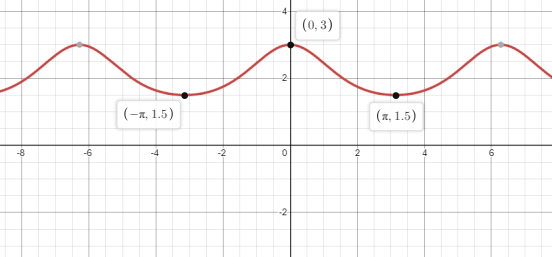
(a)
To find: TheGraphing device to graph the function.
(a)
Answer to Problem 56RE
The function has Domain=(−∞,∞) and Range=[1.5, 3] .
Explanation of Solution
Given: y=1+2cosx
Concept used:
Cosx is even function over all equation change to even .
Its Domain=(−∞,∞) and Range=[1.5, 3] .
Amplitude is A=(3−1.5)=1.5
Calculation:
Thee graph of the y=1+2cosx .

Graphing device use here is Desmos graphing calculator. from the graph modulus symbolize the positivity of the function which is shown in the graph.
Through graph range and domain can Measured which is
Domain=(−∞,∞) and Range=[1.5, 3] .
Hence the function has Domain=(−∞,∞) and Range=[1.5, 3] .
(b)
To find:whether the Function is periodic if then described it.
(b)
Answer to Problem 56RE
The period here is 2π .
Explanation of Solution
Given: y=1+2cosx
Concept used:
Period is measured as distance it takes for the entire graph to repeat.
Since the period of the Cosine function is π .
Calculation:
y=1+2cosx
Form the graph its clearly verified the periods as:
Periods=π−(−π)=2π.
Hence the period here is 2π .
(c)
To find: The graph whether the function is even or odd.
(c)
Answer to Problem 56RE
The given function is even.
Explanation of Solution
Given: y=1+2cosx
Concept used:
f(-x)=f(x) the function is an even function.
f(-x)=-f(x) the function is and odd function
Calculation:
y=1+2cosx
Since Cosx even functions and overall becomes even function so, the function is even function.
f(-x)=1+2cos(-x)=1+2cosx=f(x)∀x.
It looks like infinitely many arches of length π and of height 1 in the upper half plane touching the x-axis and symmetrical about y-axis. Therefore, the function takes the same value at points on the x-axis which are equidistant form the y-axis.
Hence the given function is even.
Chapter 5 Solutions
Precalculus: Mathematics for Calculus - 6th Edition
- For each graph in Figure 16, determine whether f (1) is larger or smaller than the slope of the secant line between x = 1 and x = 1 + h for h > 0. Explain your reasoningarrow_forwardPoints z1 and z2 are shown on the graph.z1 is at (4 real,6 imaginary), z2 is at (-5 real, 2 imaginary)Part A: Identify the points in standard form and find the distance between them.Part B: Give the complex conjugate of z2 and explain how to find it geometrically.Part C: Find z2 − z1 geometrically and explain your steps.arrow_forwardA polar curve is represented by the equation r1 = 7 + 4cos θ.Part A: What type of limaçon is this curve? Justify your answer using the constants in the equation.Part B: Is the curve symmetrical to the polar axis or the line θ = pi/2 Justify your answer algebraically.Part C: What are the two main differences between the graphs of r1 = 7 + 4cos θ and r2 = 4 + 4cos θ?arrow_forward
- A curve, described by x2 + y2 + 8x = 0, has a point A at (−4, 4) on the curve.Part A: What are the polar coordinates of A? Give an exact answer.Part B: What is the polar form of the equation? What type of polar curve is this?Part C: What is the directed distance when Ø = 5pi/6 Give an exact answer.arrow_forwardNew folder 10. Find the area enclosed by the loop of the curve (1- t², t-t³)arrow_forward1. Graph and find the corresponding Cartesian equation for: t X== y = t +1 2 te(-∞, ∞) 42,369 I APR 27 F5 3 MacBook Air stv A Aa T 4 DIIarrow_forward
- Middle School GP... Echo home (1) Addition and su... Google Docs Netflix Netflix New folder 9. Find the area enclosed by x = sin²t, y = cost and the y-axis.arrow_forward2. Graph and find the corresponding Cartesian equation for: (4 cos 0,9 sin 0) θ ε [0, 2π) 42,369 I APR 27 3 MacBook Air 2 tv A Aaarrow_forward30 Page< 3. Find the equation of the tangent line for x = 1+12, y = 1-3 at t = 2 42,369 APR A 27 M . tv NA 1 TAGN 2 Aa 7 MacBook Air #8arrow_forward
- Evaluate the following integrals as they are writtenarrow_forwardCalculus lll May I please have the blank lines completed, and final statement defined as a result? Thank you for the support!arrow_forward3. Consider the polynomial equation 6-iz+7z² - iz³ +z = 0 for which the roots are 3i, -2i, -i, and i. (a) Verify the relations between this roots and the coefficients of the polynomial. (b) Find the annulus region in which the roots lie.arrow_forward
 Calculus: Early TranscendentalsCalculusISBN:9781285741550Author:James StewartPublisher:Cengage Learning
Calculus: Early TranscendentalsCalculusISBN:9781285741550Author:James StewartPublisher:Cengage Learning Thomas' Calculus (14th Edition)CalculusISBN:9780134438986Author:Joel R. Hass, Christopher E. Heil, Maurice D. WeirPublisher:PEARSON
Thomas' Calculus (14th Edition)CalculusISBN:9780134438986Author:Joel R. Hass, Christopher E. Heil, Maurice D. WeirPublisher:PEARSON Calculus: Early Transcendentals (3rd Edition)CalculusISBN:9780134763644Author:William L. Briggs, Lyle Cochran, Bernard Gillett, Eric SchulzPublisher:PEARSON
Calculus: Early Transcendentals (3rd Edition)CalculusISBN:9780134763644Author:William L. Briggs, Lyle Cochran, Bernard Gillett, Eric SchulzPublisher:PEARSON Calculus: Early TranscendentalsCalculusISBN:9781319050740Author:Jon Rogawski, Colin Adams, Robert FranzosaPublisher:W. H. Freeman
Calculus: Early TranscendentalsCalculusISBN:9781319050740Author:Jon Rogawski, Colin Adams, Robert FranzosaPublisher:W. H. Freeman
 Calculus: Early Transcendental FunctionsCalculusISBN:9781337552516Author:Ron Larson, Bruce H. EdwardsPublisher:Cengage Learning
Calculus: Early Transcendental FunctionsCalculusISBN:9781337552516Author:Ron Larson, Bruce H. EdwardsPublisher:Cengage Learning





